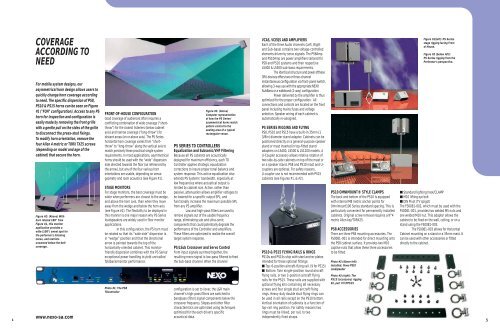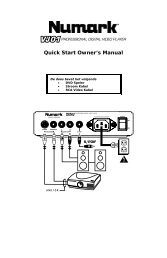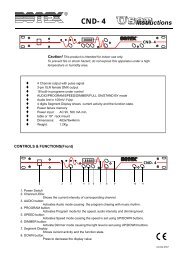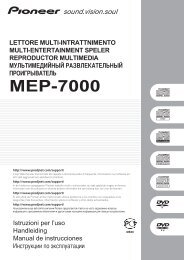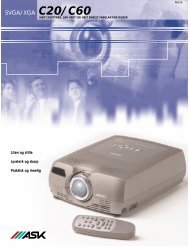NEXO loudspeakers and electronics are covered ... - bse-pro.nl
NEXO loudspeakers and electronics are covered ... - bse-pro.nl
NEXO loudspeakers and electronics are covered ... - bse-pro.nl
Create successful ePaper yourself
Turn your PDF publications into a flip-book with our unique Google optimized e-Paper software.
Nexo PS MasterNoTab.QXD 12/7/05 12:12 pm Page 4<br />
COVERAGE<br />
ACCORDING TO<br />
NEED<br />
For mobile system designs, our<br />
asymmetrical horn design allows users to<br />
quickly change horn coverage according<br />
to need. The specific dispersion of PS8,<br />
PS10 & PS15 horns can be seen on Figure<br />
#1 ("FOH" configuration). Access to any PS<br />
horn for inspection <strong>and</strong> configuration is<br />
easily made by removing the front grille<br />
with a gentle pull on the sides of the grille<br />
to disconnect the press-stud fixings.<br />
To modify horn orientation, remove the<br />
four Allen 4 metric or TORX TX25 screws<br />
(depending on model <strong>and</strong> age of the<br />
cabinet) that secure the horn.<br />
Figure #2: (Above) With<br />
horn rotated 180° from<br />
Figure #1, this monitor<br />
application <strong>pro</strong>vides a<br />
wide (100°) sweet spot for<br />
the performer’s listening<br />
zones, <strong>and</strong> restricts<br />
unwanted below-the-belt<br />
coverage.<br />
FRONT-OF-HOUSE CONFIGURATION<br />
Good coverage of audiences often requires a<br />
conflicting combination of wide coverage (“shortthrow”)<br />
for the closest listeners (below cabinet<br />
axis) <strong>and</strong> narrow coverage (“long-throw”) for<br />
distant <strong>are</strong>as (on or above axis). The PS Series<br />
horizontal horn coverage varies from “shortthrow”<br />
to “long-throw” along the vertical axis to<br />
match precisely these practical single system<br />
requirements. In most applications, asymmetrical<br />
horns should be used with the “wide” dispersion<br />
side directed towards the floor (as referenced by<br />
the arrow), but any of the four various horn<br />
orientations <strong>are</strong> usable, depending on venue<br />
geometry <strong>and</strong> room acoustics (see Figure #1).<br />
STAGE MONITORS<br />
For stage monitors, the best coverage must be<br />
wider when performers <strong>are</strong> closest to the wedge,<br />
<strong>and</strong> above the horn axis, than when they move<br />
away from the wedge <strong>and</strong> below the horn axis<br />
(see Figure #2). The flexibility to be deployed in<br />
this manner is one major reason why PS Series<br />
<strong>loudspeakers</strong> <strong>are</strong> widely used in floor monitor<br />
applications.<br />
In this configuration, the PS horn must<br />
be rotated so that its “wide side” dispersion is<br />
in “wedge” position <strong>and</strong> that the directional<br />
arrow is pointed towards the top of the<br />
horizontally-oriented cabinet. This monitorfriendly<br />
dispersion combines with the PS Series’<br />
exceptional power h<strong>and</strong>ling to yield unrivalled<br />
foldback/monitor performance.<br />
Figure #1: (Above)<br />
Computer representation<br />
of how the PS Series’<br />
asymmetrical horns match<br />
pattern control to the<br />
seating <strong>are</strong>a of a typical<br />
rectangular venue.<br />
PS SERIES TD CONTROLLERS<br />
Equalization <strong>and</strong> Subsonic/VHF Filtering<br />
Because all PS cabinets <strong>are</strong> acoustically<br />
designed for maximum efficiency, each TD<br />
Controller applies strategic equalization<br />
corrections to insure <strong>pro</strong>per tonal balance <strong>and</strong><br />
system response. This active equalization also<br />
extends PS Systems’ b<strong>and</strong>width, especially at<br />
low frequencies where acoustical output is<br />
limited by cabinet size. Active, rather than<br />
passive, attenuation allows amplifier voltages to<br />
be lowered for a specific output SPL, <strong>and</strong><br />
functionally increase the maximum possible SPL<br />
from any PS amplifier.<br />
Low <strong>and</strong> high-pass filters <strong>are</strong> used to<br />
remove signals out of the usable frequency<br />
range, eliminating sub <strong>and</strong> ultra-sonic<br />
components that could potentially degrade the<br />
performance of the Controller <strong>and</strong> amplifiers.<br />
These filters <strong>are</strong> optimized to realize the overall<br />
target system response.<br />
PS/LSub Crossover <strong>and</strong> Servo Control<br />
From input signals summed together, the<br />
resulting mono signal is low-pass filtered to feed<br />
the Sub-bass channel. When the channel<br />
VCAS, VCEQS AND AMPLIFIERS<br />
Each of the three Audio channels (Left, Right<br />
<strong>and</strong> Sub-bass) contains two voltage-controlled<br />
elements driven by servo signals. The PS8Amp<br />
<strong>and</strong> PS10Amp <strong>are</strong> power amplifiers tailored for<br />
PS8 <strong>and</strong> PS10 systems <strong>and</strong> their respective<br />
LS400 & LS500 sub-bass requirements.<br />
The identical structure <strong>and</strong> power ofthese<br />
3RU devices offers two or three-channel<br />
instantaneous configuration via front-panel switch,<br />
allowing 3-way use with the ap<strong>pro</strong>priate <strong>NEXO</strong><br />
SubBass or a wideb<strong>and</strong> (2-way) configuration.<br />
Power delivered by the amplifier is thus<br />
optimized for the <strong>pro</strong>per configuration. All<br />
connections <strong>and</strong> controls <strong>are</strong> located on the front<br />
panel including mains fuses <strong>and</strong> voltage<br />
selection. Speaker wiring of each cabinet is<br />
automatically re-assigned.<br />
PS SERIES RIGGING AND FLYING<br />
PS8, PS10 <strong>and</strong> PS15 have a built-in 35mm (1<br />
3/8in) diameter st<strong>and</strong> adapter. Cabinets can be<br />
positioned directly on a general-purpose speaker<br />
st<strong>and</strong> or mast inserted in top-fitted st<strong>and</strong><br />
adapters on LS400, LS500 & LS1200 models. A<br />
U-Coupler accessory allows relative rotation of<br />
two side-by-side cabinets on top of the mast or<br />
on a speaker st<strong>and</strong>. PS8 <strong>and</strong> PS10 mast <strong>and</strong> U-<br />
couplers <strong>are</strong> optional. For safety reasons,<br />
U-coupler use is not recommended with PS15<br />
cabinets (see Figures #1, & #2).<br />
PS10 OMNIMOUNT® STYLE CLAMPS<br />
The back <strong>and</strong> bottom of the PS10 is equipped<br />
with internal M8 metric anchor points for<br />
Omnimount100 Series st<strong>and</strong>ard spacing. This is<br />
particularly convenient for permanently installed<br />
cabinets. Original screw removal requires a N°4<br />
metric Allen key/TORX25.<br />
PS8 ACCESSORIES<br />
There <strong>are</strong> three PS8 mounting accessories. The<br />
FS0081-001 is intended for direct mounting onto<br />
the PS8 cabinet surface. It <strong>pro</strong>vides two M10<br />
captive nuts that allow these three accessories<br />
to be fitted:<br />
Figure #1(left): PS Series<br />
stage rigging facing Front<br />
of House.<br />
Figure #2 (below left):<br />
PS Series rigging from the<br />
Performer’s perspective.<br />
■ St<strong>and</strong>ard lighting hook/CLAMP<br />
■ M10 lifting eye bolt<br />
■ DIN Pivot (TV spigot)<br />
The FS0081-002, which must be used with the<br />
FS0081-001, <strong>pro</strong>vides two welded M5 nuts <strong>and</strong><br />
one welded M10 nut. This adapter allows the<br />
cabinet to be fixed on the wall, ceiling, or on a<br />
st<strong>and</strong> using the FS0081-003.<br />
The FS0081-003 allows for Horizontal<br />
Cabinet mounting on a st<strong>and</strong> or a 35mm mast. It<br />
can be used with other accessories or fitted<br />
directly to the cabinet.<br />
PS10 & PS15 FLYING RAILS & RINGS<br />
PS10s <strong>and</strong> PS15s ship with steel anchor plates<br />
intended for these optional fittings:<br />
Photo #2 (Above left):<br />
■ Top: 6-position aircraft-flying rail. (9 for PS15) Installed, flown PS10<br />
■ Bottom: Twin single-position round aircraft<br />
Loudspeaker<br />
flying rails, or two 3-position aircraft flying Photo #3 (right): The<br />
rails for the PS15. These rails <strong>are</strong> supplied with PS15 (accessory) rigging<br />
optional flying kits containing all necessary<br />
kit, part # FLYPS15<br />
Photo #1: The PS8<br />
configuration is set to Xover, the L&R main<br />
screws <strong>and</strong> four single stud aircraft flying<br />
TDcontroller<br />
channel's high-pass filters <strong>are</strong> switched to<br />
rings. Heavy-duty double stud flying rings can<br />
b<strong>and</strong>pass (filter) signal components below the<br />
be used in all rails except on the PS10 bottom.<br />
crossover frequency. Slopes <strong>and</strong> other filter<br />
Vertical orientation of cabinets is a function of<br />
characteristics <strong>are</strong> optimized using techniques<br />
top-rail ring position. For safety reasons two<br />
optimized for the each driver’s specific<br />
rings must be linked, per rail, to two<br />
4<br />
www.nexo-sa.com<br />
acoustical data.<br />
independently fixed straps.<br />
5


